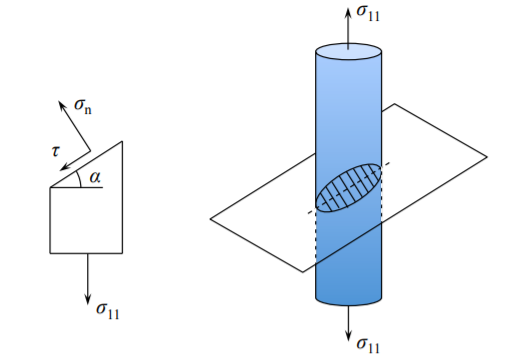11.8: Tresca Yield Condition
- Page ID
- 24885
The stress state in uni-axial tension of a bar depends on the orientation of the plane on which the stresses are resolved. In Chapter 2 it was shown that the shear stress \(\tau\) on the plane inclined to the horizontal plane by the angle \(\alpha\) is
\[\tau = \frac{1}{2} \sigma_{11} \sin 2\alpha \]
where \(\sigma_{11}\) is the uniaxial tensile stress, see Figure (\(\PageIndex{1}\)).

The maximum shear occurs when \(\sin 2\alpha = 1\) or \(\alpha = \frac{\pi}{4}\). Thus in uniaxial tension
\[\tau_{\text{max}} = \frac{\sigma_{11}}{2} \]
Extending the analysis to the 3-D case (see for example Fung) the maximum shear stresses on three shear planes are
\[\tau_1 = \frac{|\sigma_1 − \sigma_2|}{2}, \quad \tau_2 = \frac{|\sigma_2 − \sigma_1|}{2}, \quad \tau_3 = \frac{|\sigma_3 − \sigma_1|}{2} \]
where \(\sigma_1\), \(\sigma_2\), \(\sigma_3\) are principal stresses. In 1860 the French scientist and engineer Henri Tresca put up a hypothesis that yielding of the material occurs when the maximum shear stress reaches a critical value
\[\tau_o = \text{ max } \left\{ \frac{|\sigma_1 − \sigma_2|}{2}, \frac{|\sigma_2 − \sigma_3|}{2}, \frac{|\sigma_3 − \sigma_1|}{2} \right\} \]
The unknown constant can be calibrated from the uniaxial test for which Equation (11.4.9) holds. Therefore at yield \(\tau_o = \sigma_y/2\) and the Tresca yield condition takes the form
\[\text{ max } \{|\sigma_1 − \sigma_2|, |\sigma_2 − \sigma_3|, |\sigma_3 − \sigma_1|\} = \sigma_y \]
In the space of principal stresses the Tresca yield condition is represented by a prismatic open-ended tube, whose intersection with the octahedral plane is a regular hexagon, see Figure (\(\PageIndex{2}\)).

For plane stress, the intersection of the prismatic tube with the plane \(\sigma_3 = 0\) forms a familiar Tresca hexagon, shown in Figure (\(\PageIndex{3}\)).

The effect of the hydrostatic pressure on yielding can be easily assessed by considering \(\sigma_1 = \sigma_2 = \sigma_3 = p\). Then
\[\sigma_1 − \sigma_2 = 0 \]
\[\sigma_2 − \sigma_3 = 0 \]
\[\sigma_3 − \sigma_1 = 0 \]
Under this stress state both von Mises yield criterion (Equation (??)) and the Tresca criterion (Equation (??)) predict that there will be no yielding.


